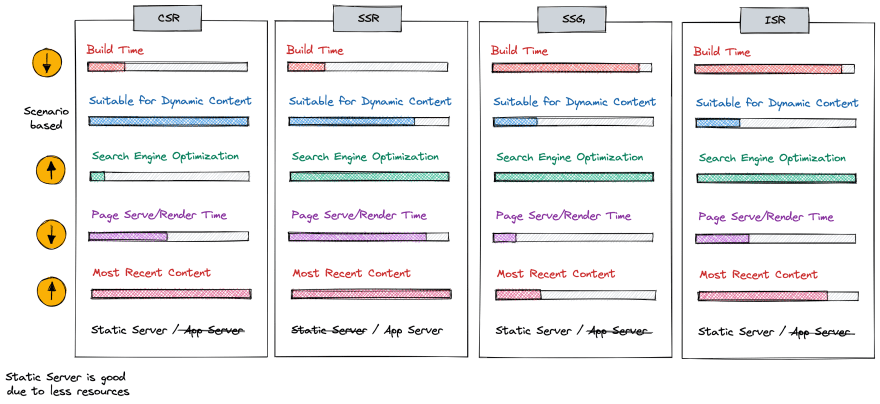Detailed Difference Between CSR, SSR, and ISG with Examples
 James
James
Understanding SSR, ISR, CSR, and SSG: A Guide for Software Developers
Are you a software developer looking to delve into the world of client-side frameworks? If so, you've probably encountered terms like SSR, ISR, CSR, and SSG. But what do these acronyms actually mean, and how do they impact your development projects? In this article, we will break down the differences between these four concepts, explore how they work, highlight their advantages, and provide guidance on when to use them. We'll also offer some real-world examples of client-side frameworks to help you gain a better understanding. So, let's dive into the world of SSR, ISR, CSR, and SSG.
Server-Side Rendering (SSR)
What is SSR?
Server-Side Rendering (SSR) is a technique that allows web pages to be generated on the server and sent to the client as fully rendered HTML. In simpler terms, when a user requests a page, the server processes the request and sends back an HTML page with all the content already in place.
How Does SSR Work?
SSR involves the server taking care of the initial rendering of a web page. When a user visits a website, the server fetches the required data, renders the page, and sends it as a complete HTML document. This approach ensures that search engines can easily index the content, contributing to better SEO.
Advantages of SSR
SEO-Friendly: Search engines can crawl and index SSR pages more effectively, improving search visibility.
Improved Initial Page Load: Users see content faster since the server sends a pre-rendered page.
Robust User Experience: SSR pages are more accessible to users with JavaScript disabled.
When to Use SSR
You should consider using SSR when you have content that needs to be indexed by search engines, or when delivering a fast initial page load is crucial, such as in e-commerce sites and news platforms.
Examples of Client-Side Frameworks Using SSR
Next.js
Nuxt.js
Incremental Static Regeneration (ISR)
What is ISR?
Incremental Static Regeneration (ISR) is a technique that combines the best of SSR and SSG. It allows developers to pre-render pages at build time and then re-generate them at runtime when data changes, hence the term "incremental."
How Does ISR Work?
In ISR, pages are initially rendered at build time, just like SSG. However, when data updates are needed, the pages are regenerated without the need for a full rebuild, which greatly improves performance and reduces server load.
Advantages of ISR
Balanced Performance: ISR offers the benefits of SSR and SSG, providing both SEO and fast page loads.
Dynamic Content: You can have dynamic content while keeping your website pre-rendered.
When to Use ISR
Use ISR when you need a balance between SEO and dynamic content. It's suitable for blogs, news sites, and any content that changes over time.
Examples of Client-Side Frameworks Using ISR
Next.js
Gatsby
Client-Side Rendering (CSR)
What is CSR?
Client-Side Rendering (CSR) is a technique where the web page is initially delivered as a shell, and the content is populated by the client's web browser using JavaScript.
How Does CSR Work?
When a user visits a CSR-based website, the initial HTML page contains placeholders for content. JavaScript running in the browser then fetches data from the server and populates these placeholders, creating a dynamic user experience.
Advantages of CSR
Highly Interactive: CSR allows for highly dynamic and interactive web applications.
Lower Server Load: The server primarily focuses on providing data, reducing the load on the server.
When to Use CSR
Consider CSR when your application requires a high level of interactivity and dynamic content, like single-page applications (SPAs) and complex dashboards.
Examples of Client-Side Frameworks Using CSR
React
Vue.js
Static Site Generation (SSG)
What is SSG?
Static Site Generation (SSG) is a technique where web pages are pre-built during the build process and served as static HTML files. These files can be cached and served directly to the user.
How Does SSG Work?
During the build phase, the server generates HTML files for each page. These files can be served to users without any server processing, resulting in lightning-fast page loads.
Advantages of SSG
Blazing-Fast Loading: SSG provides the fastest loading times since there is no server-side processing.
Scalability: SSG can handle high traffic loads due to the cached, pre-generated HTML.
When to Use SSG
Use SSG when you have content that doesn't change frequently, such as blogs, documentation sites, and marketing pages.
Examples of Client-Side Frameworks Using SSG
Jekyll
Hugo
Conclusion
In summary, Server-Side Rendering (SSR), Incremental Static Regeneration (ISR), Client-Side Rendering (CSR), and Static Site Generation (SSG) are four distinct techniques used in web development, each with its advantages and use cases. Choosing the right approach depends on the specific needs of your project, whether it's SEO, fast initial page loads, dynamic content, or scalability. By understanding these techniques, you can make informed decisions to create efficient and user-friendly web applications.
Frequently Asked Questions (FAQs)
Which rendering method is best for SEO?
- For optimal SEO, Server-Side Rendering (SSR) is the best choice, as it provides fully rendered HTML pages that search engines can easily index.
Can I use Incremental Static Regeneration (ISR) for e-commerce websites?
- Yes, ISR can be an excellent choice for e-commerce websites, as it combines the benefits of SSR and SSG, offering both SEO advantages and dynamic content updates.
Is Client-Side Rendering (CSR) suitable for content-heavy websites?
- CSR is more suited for applications with a high degree of interactivity
Subscribe to my newsletter
Read articles from James directly inside your inbox. Subscribe to the newsletter, and don't miss out.
Written by
